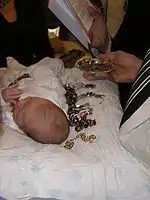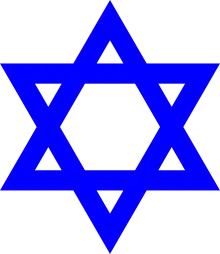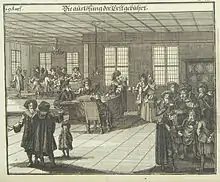Pidyon haben
The pidyon haben (Hebrew: פדיון הבן) or redemption of the first-born (if male and not by caesarean)[1] is a mitzvah in Judaism whereby a Jewish firstborn son is "redeemed" by use of silver coins from his birth-state of sanctity, i.e. from being predestined by his firstborn status to serve as a priest.
 | |
| Halakhic texts relating to this article | |
|---|---|
| Torah: | Exodus 13:12–15 Exodus 22:29 Exodus 34:20 Numbers 3:45 Numbers 8:17 Numbers 18:16 Leviticus 12:2–4 |
| Shulchan Aruch: | Yoreh De'ah 305 |
| Part of a series on |
| Jews and Judaism |
|---|
 |
|
| Part of a series of articles on |
| Priesthood in Judaism |
|---|
| |
|
Kohen · Recognition of priestly descent Priestly covenant |
The redemption is attained by giving five silver coins to a kohen (a patrilineal descendant of the priestly family of Aaron).
Pidyon haben is a relatively rare ceremony. A family does not perform the ceremony if its firstborn is a girl, born by caesarian section, preceded by a miscarriage, or if either grandfather is a kohen or a Levite.
Biblical references
In the Hebrew Bible the laws (see mitzvah) concerning the redemption of the first-born male are referred to in Exodus, Numbers and Leviticus:
that thou shalt set apart unto the LORD all that openeth the womb; every firstling that is a male, which thou hast coming of a beast, shall be the LORD'S. And every firstling of an ass thou shalt redeem with a lamb; and if thou wilt not redeem it, then thou shalt break its neck; and all the first-born of man among thy sons shalt thou redeem. And it shall be when thy son asketh thee in time to come, saying: What is this? that thou shalt say unto him: By strength of hand the LORD brought us out from Egypt, from the house of bondage. and it came to pass, when Pharaoh would hardly let us go that the LORD slew all the firstborn in the land of Egypt, both the first-born of man, and the first-born of beast; therefore I sacrifice to the LORD all that openeth the womb, being males; but all the first-born of my sons I redeem.
The redemption price for firstborn non-Levites was set at 5 shekels:
Every thing that openeth the womb, of all flesh which they offer unto the LORD, both of man and beast, shall be thine; howbeit the first-born of man shalt thou surely redeem, and the firstling of unclean beasts shalt thou redeem. And their redemption-money--from a month old shalt thou redeem them--shall be, according to thy valuation, five shekels of silver, after the shekel of the sanctuary--the same is twenty gerahs.
Principles
The Shulchan Aruch states that when a Jewish woman gives birth to a firstborn male by natural means,[2] then the child must be "redeemed".[3] The father[4] of the child must "redeem" the child from a known kohen[5] representing the original Temple priesthood, for the sum of five silver shekels,[3] or equivalent in country's currency (if it has silver currency of the correct weight). The procedure does not apply when the father is a kohen or Levite, and does not normally apply when the mother is the daughter of one.[6]
This redemption ceremony is performed when at least thirty days have passed since the child's birth. If the 31st day falls on Shabbat or a festival, the redemption is delayed, because any sort of business transaction is not allowed on those days.[7] These days are counted from sunset to sunset, and the day of birth counts as the first day. While the redemption could be performed immediately after dark on the 31st night, it is usually done the next day; but if the 31st day is a fast day, it is done the previous night, so that it can be accompanied by a festive meal.[8] It is also possible to hold the ceremony on the 30th day itself, if it will be impossible to perform it the next day, so long as at least one synodic month has passed since the moment of birth.[9]
Exemptions
If a woman gives birth to a second son naturally when the first son was born by caesarean section, that child is not redeemed either.[10] Additionally, a first-born male does not require redemption if his birth was preceded by an earlier miscarriage by the mother that occurred after the third month of pregnancy. However, if the miscarriage occurred during the first 40 days of pregnancy, redemption is required. If the previous miscarriage occurred after forty days, but before the fetus developed distinguishing characteristics, redemption of the first-born is still required, but the blessing said by the father is omitted.[11]
Levites, including kohanim, do not redeem their children through the pidyon haben ceremony. The reason is that the Levites, as substitutes for the first-born, are pledged to minister and assist the kohanim in divine service, and cannot be redeemed from this service obligation.
The first-born son from a Levite's daughter is not redeemed;[12] likewise the first-born son of a kohen's daughter, as long as the father is Jewish.[13]
Ceremony

In the traditional ceremony, the father brings the child to the kohen and recites a formula, or responds to ritual questions, indicating that this is the Israelite mother's firstborn son and he has come to redeem him as commanded in the Torah. If the family is Sephardic, the kohen asks the mother if the child is indeed her firstborn son and if she did not miscarry in the past. The kohen asks the father which he would rather have, the child or the five silver shekels which he must pay. The father states that he prefers the child to the money, then he recites a blessing and hands over five silver coins (or an equivalent amount of total silver). The kohen holds the coins over the child and declares that the redemption price is received and accepted in place of the child. He then blesses the child. (Note: The kohen would not receive the child if the father would refuse to redeem the boy. The function of the question[14] is merely to endear the mitzvah to the father.)
The ceremony traditionally takes place before a minyan of 10 men. The child is sometimes presented on a silver tray, surrounded by jewelry lent for the occasion by women in attendance. This is to contrast with the golden calf, when gold and jewelry was used for a sinful purpose.[15]
The event starts by beginning a festive meal (unlike a brit milah or wedding where the meal comes after the ceremony).[16] If the family is Sephardic, the event starts with the ceremony. Guests in some places are given cloves of garlic and cubes of sugar to take home: these strongly flavored foods can be used to flavor a large quantity of food which will in some sense extend the mitzvah of participation in the ceremony to all who eat them.
If a first-born son reaches bar mitzvah age without having been redeemed, he is responsible for arranging the mitzvah himself as soon as possible.
Coins
Contemporary religious authorities believe that the Shekel HaKodesh (Holy Shekel) of the Temple was larger and of purer silver content than the standard shekel used for trade in ancient Israel. Halakha requires that the coins used have a requisite total amount of actual silver. There are varying opinions as to the correct amount of silver, they fall in between 96.15 grams and 102 grams. Coins which do not contain the requisite amount of silver do not result in a valid redemption.
The Israeli Mint has minted two sets of coins for this purpose: an edition of 20.57 gram silver commemorative coins, five of which would come to 102 grams of silver,[17] and a special edition 26 gram silver commemorative coins, five of which would come to 130 grams of silver.[18] Pre-1936 American silver dollars (commonly known as Morgan dollars or Peace dollars) weigh 26.73 grams of 90% silver content and hence contain 24.06g of pure silver, although such coins have become increasingly rare (modern U.S. coins contain no silver). Four American Silver Eagle coins, specially minted coins sold to collectors and investors which contain 31.1035 grams of 99.9% pure silver, or five of the above-mentioned specially minted silver coins of Israel are commonly used for pidyon haben in the United States. One may use silver bullion as well; it is not necessary for it to be a coin per se.
Moreover, it is not mandatory to redeem the son in silver coins, and the ceremony can be held using any object worth the same value as five silver coins in the same day, other than banknotes, which, according to the Shulchan Aruch, are considered to be a promissory note, that is not acceptable for the ceremony.[19]
Although the silver coins are the payment to the kohen under torah law and are one of the twenty-four kohanic gifts, they are sometimes returned by the kohen to the family as a gift for the child, although halachic authorities stipulate that, for the pidyon to be valid, the choice of returning the coins as a gift rest entirely upon the kohen whereas pressuring the kohen to do so would render the redemption invalid.[20]
Pidyon Certificate
Some kohens officiating for the pidyon ceremony will present the father with a "Pidyon HaBen Certificate" of the pidyon transaction, the certificate will usually be framed for display and may serve as a receipt (and evidence) that the transaction was done according to halacha (i.e. the kohen was not pressured to return the coins), with the kohen and two witnesses ("Eidim") affixing their signatures at the time of the ceremony.
Women and pidyon haben
The question of a bat kohen accepting pidyon haben money on her own behalf[21] is not done in practice per a lengthy responsum on the topic by Joseph Saul Nathanson.
Traditional Jewish interpretation

According to the traditional rabbinic interpretation, in the early part of the Bible, as recorded in the Book of Genesis, the duties of a priest fell upon the eldest son of each family. The first-born was to be dedicated to God in order to perform this task.
Following the Israelite Exodus from Egypt, after the nation had sinned with the golden calf, the priesthood was taken away from the first-borns, and given to the Tribe of Levi, specifically to the kohanim, that is: High Priest Aaron, his children, and their descendants. At the same time it was instituted that the first born of each family should be redeemed; i.e. they would be bought back from the dedication to God that would previously have been required of them. Levites were substituted for the first-born and wholly given to divine service:
'And I, behold, I have taken the Levites from among the children of Israel instead of every first-born that openeth the womb among the children of Israel; and the Levites shall be Mine; for all the first-born are Mine: on the day that I smote all the first-born in the land of Egypt I hallowed unto Me all the first-born in Israel, both man and beast, Mine they shall be: I am the LORD.'
The first-born male of every clean animal was to be given up to the priest for sacrifice.[22] The first-born donkey, if not redeemed, was to be put to death.[23] There is no need for redemption of any other non-kosher animal, for the firstborn status only applies to kosher animals.[24]
See also
References
-
- Eugene Joseph Cohen (1984), Guide to ritual circumcision and redemption of the first-born son, Volume 1: "The Redemption of the First-Born – A mother's first-born is to be dedicated to the service of God, in accordance with the verse, "Sanctify the first-born who opens the womb." This sanctification was the result of an historical event."
- Michele Klein (2000), A Time to Be Born: Customs and Folklore of Jewish Birth, p. 224: "They have attributed healing properties to the stick. 54 Redemption of the First-Born Son. A first child has special significance for both parents, and this was as true in biblical times as today, but then only when the child was male"
- Mark Washofsky (2001), Jewish living: a guide to contemporary reform practice, p. 148: "Redemption of the First-born Son (Pidyon Haben) – In Jewish tradition, the first-born son is to be "redeemed" from God. This originates in the belief that God "acquired" the Israelite first-born by sparing them from makkat bekhorot"
- Ruth Langer (2005), To Worship To Worship God Properly: Tensions Between Liturgical Custom and Halakhah in Judaism (Monographs of the Hebrew Union College Series), p. 73 ("Redemption of the First Born").
- i.e. vaginally and not by Caesarean section
- Shulchan Aruch Yoreh De'ah 305:1
- Shulchan Aruch Yoreh De'ah 305:2
- Shulchan Aruch Yoreh De'ah 305:3
- Shulkhan Arukh Yoreh De'ah 305:18
- Shulchan Aruch Yoreh De'ah 305:11
- Shach 305:12
- Shach 305:19, at the end, citing the Bach.
- Shulchan Aruch Yoreh De'ah 305:24
- Donin, Hayim Halevy (1972). To Be a Jew. Basic Books. p. 277. ISBN 0-465-08624-1.
- regardless of whether the father is Jewish, (Shulchan Aruch 305:18)
- A boy whose mother is a Bat Kohen and whose father is a non-Jew requires a pidyon haben ceremony. Timing may require the boy to await Bar Mitzvah. see Igros Moshe Y.D. 195. "Orthodox Union, NCSY Newsletter Torah Tidbits, Parshat Chukat 5762". ou.org. Archived from the original on 6 June 2011. Retrieved 17 March 2018.
- Siddur Nachlas Shimon/ The Artscroll Weekday Siddur. Mesorah Publications, Ltd. p. 220. ISBN 0899066682.
- "What are some customs observed at a Pidyon Haben? - life cycle pidyon haben mitzvot". www.askmoses.com. Retrieved 17 March 2018.
- "The Halachos of Pidyon Haben". Archived from the original on 2014-05-05. Retrieved 2014-05-05.
- "Pidyon Haben". israelmint.com. 6 July 2020. Retrieved 6 July 2020.
- "Shulchan Arukh". sefaria.org.il. 6 July 2020. Retrieved 6 July 2020.
- Responsa "Chsam Sofer", to Yoreh Deah, Chap. 291
- Midreshet Lindenbaum, Bnot Kohanim: Our Holy Daughters Archived 2009-01-18 at the Wayback Machine
- Deuteronomy 12:6; Exodus 13:12, 34:20; Numbers 18:15–17
- Exodus 13:13; 34:20
- Leviticus 27:27. See Rashi there. Also see Rashi to Exodus 34:19
External links
| Wikimedia Commons has media related to Pidyon haben. |
